Andrology-Open Access
Open Access
ISSN: 2167-0250
+44 1300 500008
ISSN: 2167-0250
+44 1300 500008
Research - (2020)Volume 9, Issue 2
The results of a study evaluating the influence of narrow-spectrum Infraded (IR) Radiation of the far range on the erectile function of 39 patients with ED of various etiologies are presented. It was shown the use of long-range infrared emitters in the treatment of ED is an effective and safe method of therapy. Non-invasiveness, the absence of side effects, the rapid improvement of erectile function, the possibility of using it on an outpatient basis are undoubted advantages of this type of treatment.
Erectile dysfunction; Treatment; Far-infrared radiation
Over the past 15-20 years, promising and encouraging methods of erectile disorders treating have been proposed-this is genetic engineering and the use of stem cells. However, these techniques are invasive and expensive; in addition, most studies have been performed on animals [1,2]. Gene therapy can be an effective alternative to existing drugs for the treatment of erectile dysfunction, or enhance their effect when used together [3,4]. A pathogenetically justified method for correcting vascular disorders in the tissues of the penis can be a low-intensity shock wave. The first clinical studies showed encouraging results from this assumption [5,6]. All clinical shockwave devices generate waves that converge at one focal point. That is, the therapeutic region is an ellipsoid. This is necessary in the treatment of stones, in orthopedics, but creates problems in the treatment of ED, because it is necessary to move the wave source in several positions along the penis, while there is no effective positioning on the leg.
To effectively transmit shock waves to the penis, a linear shock wave therapy has been developed specifically for the treatment of ED. The effectiveness of treatment is long-term in nature, linear shock wave therapy has an effect on angiogenesis in the penis, which makes it indicated for vasculogenic ED. Efficiency and safety are rated as good [7]. It is known that low-intensity acoustic waves have a stimulating effect on in vitro angiogenesis and also increase the expression of both Vascular Endothelial Growth Factor (VEGF) and receptors corresponding to vascular factor (Flt-1) in cultured human umbilical vein endothelial cells [8]. Like acoustic waves, infrared (IR) radiation has a wave propagation pattern. In addition, IR radiation is propagated by quanta (photons), which make this type of electromagnetic radiation “deeply penetrating”. IR rays are absolutely safe for the human body, unlike x-rays, ultraviolet, or gamma rays. Human own radiation is in the range of 9 μm-10 μm (Figure 1).
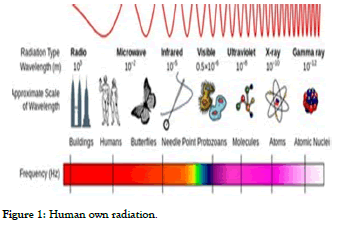
Figure 1: Human own radiation.
Long-range infrared radiation is located on the scale of electromagnetic waves between microwaves and optical infrared ranges (Figure 2) and is interesting, first of all, because it contains Molecular Emission and Absorption Spectra (MEAS) of various cellular metabolites (NO, CO, reactive oxygen species, etc.).
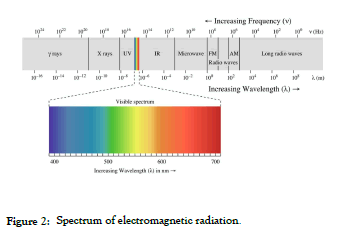
Figure 2: Spectrum of electromagnetic radiation.
It was found that irradiation of the body with infrared energy of 0.02 eV-0.3 eV leads to the activation of anabolic processes and transport processes in the cell. In particular, protein synthesis, oxygen uptake on an iron ion in hemoglobin and myoglobin, and transfer of metal ions through cell membranes are enhanced [9]. One of the main properties of long-range infrared radiation is the dependence of the effects on the phase of biological development and on the initial state of the object: the long-range infrared radiation practically does not affect the normal functioning healthy organism, and if pathology occurs, it can regulate its functioning within the limits inherent in this biological species, which is confirmed experimentally and is consistent with the literature [10-12].
It is known about the positive effect of long-range IR radiation on the functional properties of platelets and rheological parameters during in vitro irradiation of animal blood [13,14]. And also the initial rheological indices and functional activity of platelets are restored upon irradiation with an IR emitter of a long range of white rats in a state of immobilization stress [15]. There is reasoned evidence indicating that long-range infrared radiation (electromagnetic radiation of the terahertz range) is a promising method that affects the pathogenetic mechanisms of the development of cardiovascular pathology [16]. Infrared radiation in the terahertz range causes an increase in the production of nitric oxide by vascular endothelium, which is accompanied by the normalization of reduced basal and induced vasodilating activity in animals in a state of acute immobilization stress [17]. The course of exposure to terahertz waves in animals with prolonged stress causes an increase in the concentration of nitrites-stable metabolites of nitric oxide [18], and a decrease in the concentration of endothelin-1 in blood serum [19]. This helps to normalize the balance of production of vasoconstrictor and vasodilator substances by endothelium, that is, prevents the development of endothelial dysfunction.
39 patients with erectile dysfunction (ED) of various etiologies were examined by us. The average age of patients was 53.1 13.8 years (38-74 years), of which 28 patients were aged 38-55 years; 56 and more years-11 patients. After the examination, which included the questionnaire International Index of Erectile Function -5 (IIEF-5), dopplerography of the cavernous arteries of the penis, patients were treated with long-range narrow-spectrum IR emitters according to our method: 8 sessions of 15 minutes twice in a day with GI and ZB series emitters type "Chair"; locally on the penis area the radiator of the ZB series (wavelength 22 μm) for 3 minutes twice in a day, 8 sessions per treatment course (Figures 3-5).
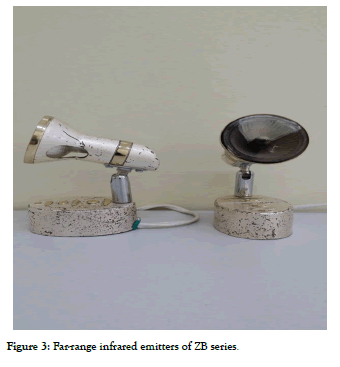
Figure 3: Far-range infrared emitters of ZB series.
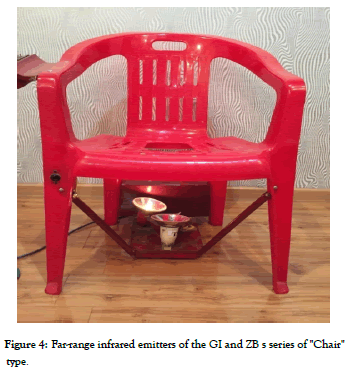
Figure 4: Far-range infrared emitters of the GI and ZB s series of "Chair" type.
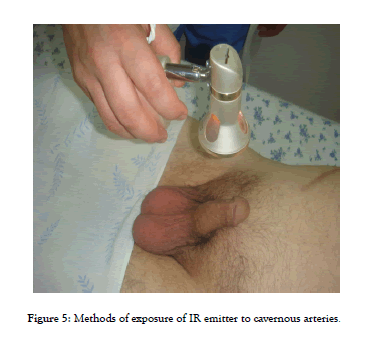
Figure 5: Methods of exposure of IR emitter to cavernous arteries.
The control examination included the completion of the IIEF-5 questionnaire, which was carried out in 1 and 2 months after treatment. Statistical data processing was carried out using tstudent test and Wilkinson criterion. The probability level at p<0.05 is considered statistically significant.
When analyzing the IIEF-5 questionnaire, it was found that ED in severity was: mild in 5 (12.8%) men, moderate in 23 (58.9%) patients, severe in 11 (28.2%). The etiological factors of ED (and their combination) were arterial hypertension-in 27, diabetes mellitus-in 13, coronary heart disease-in 11. 34 (87.1%) men were overweight and obese. Almost a third of patients-12 (30.7%) were smokers. Most (76.9%) of men showed a gradual increase in signs of ED. Regarding concomitant diseases (Antihypertensive drugs, Anti-lipid and Hypoglycemic drugs), 79.4% of patients received regular medication, the volume of which did not change during the study. According to the results of a comprehensive andrological examination, depending on the prevailing pathogenesis, arteriogenic ED was observed in 36 (92.3%) patients, veno-occlusive in 3 (7.7%). The results of the survey on the IIEF-5 questionnaire at all stages of treatment are presented in (Table 1).
| The indicator of the IIEF-5 questionnair | Before treatment | After treatment | ||
|---|---|---|---|---|
| At the end of IR therapy | After 1 month | After 2 months | ||
| Erectile function (1-30) | 14,3+-1,6 | 19,1+-2,2* | 22,7+-1,9* | 23,1+-2,2* |
* Statistically significant changes in indicators compared to baseline (p<0.05 according to Wilconson's criterion)
Table 1: The indicators of the IIEF-5 questionnaires at various stages treatment.
As can be seen from the table, after treatment, the indicator “Erectile Function” reliably increased by 33.5%, in dynamics this indicator increased by another 20.9%. The outcome total increase was 61.5%. This indicates a gradually advancing therapeutic effect and the restoration of erectile function. It should be noted that patients began to notice a subjective improvement in erectile function after the 2nd-3rd session of the use of narrow-spectrum long-range infrared emitters.
In total, we obtained a positive result from the use of narrowspectrum IR emitters for ED in 28 (71.8%) patients. At the same time, the treatment efficiency with mild ED was 80% (4 patients), with a moderate degree of ED-82.6% (19 patients), and with a severe degree-45.4% (5 patients) (Graph 1). Improvement of erectile function without the use of any other type of treatment, except for IR emitters, was achieved in 13 (46.4%) patients with mild and moderate ED.
Thus, based on the results of studies and clinical observations, it can be reliably stated that the use of narrow-spectrum IR emitters improves the endothelial function of the cavernous arteries. The positive dynamics of the indicator “ Erectile function” according to IIEF-5 is a confirmation of this. Longrange narrow-spectrum infrared radiation is an effective, safe, and non-invasive method for the correction of erectile dysfunctions of vasculogenic etiology. In patients with mild to moderate severity of ED, the technique can be implemented as an independent type of treatment, and in cases of severe ED, it is recommended to include the technique in the general scheme of combination therapy.
Citation: Ashurmetov A (2020) Narrow Spectral Infrared Radiation in Treatment Erectile Disorders of Vasculogenic Etiology. Andrology 9:206. doi: 10.35248/2167-0250.2020.9.206
Received: 21-May-2020 Accepted: 29-May-2020 Published: 15-Jun-2020 , DOI: 10.35248/2167-0250.20.9.206
Copyright: © 2020 Ashurmetov A. This is an open-access article distributed under the terms of the Creative Commons Attribution License, which permits unrestricted use, distribution and reproduction in any medium, provided the original author and source are credited.